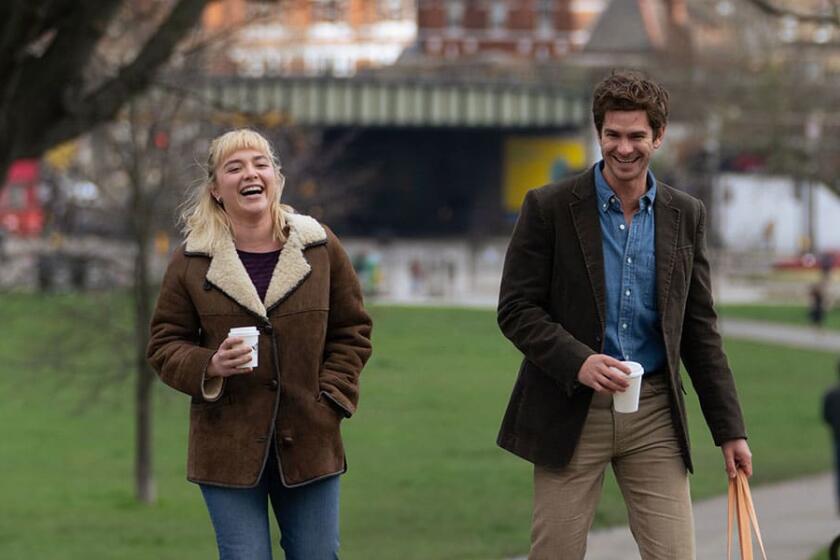Awash in the sweet life
To have seen Federico Fellini’s “La Dolce Vita” when it opened in the U.S. in 1961 as a graduate school dropout turned erstwhile construction worker with a love of movies and a secret desire to review them was an unforgettable, totally tantalizing experience. I could never have guessed that, when it was re-released -- oddly, by American International Pictures, purveyors of drive-in movies for teens -- in a surprisingly painstakingly dubbed version five years later, that it would fall to me to review it in The Times. So careful was the dubbing process that Fellini’s characters seemed more rounded, and his vast, captivating fresco of contemporary society acquired more depth. (Or maybe it was just that I was five years older and a tad more mature).
To watch “La Dolce Vita” from time to time over the years as I was experiencing firsthand some of the glittery world in which Fellini’s journalist traveled is to appreciate all the more the maestro’s detached yet mesmerizing view of the unending parade of human folly and longing. Today “La Dolce Vita” cannot be looked at without a sense of loss, for it was the film in which Fellini found his ideal alter ego in Marcello Mastroianni, and now they’re both gone. One of the key works of the modern cinema, “La Dolce Vita” looks ever more prescient. A brilliantly conceived epic fable about a gossip columnist, Marcello Rubini (Mastroianni), adrift in Rome’s high life, it introduced the term “paparazzi” into the vocabulary and depicted, with a judicious mixture of satire and compassion, the world of celebrity, which has never been more avidly chronicled than right now, in supermarket tabloids, weekly entertainment magazines, TV shows and on the Internet. Clearly, there seems no end in sight for the public’s obsession with celebrity and the media’s dedication to exploiting it.
“La Dolce Vita” is also one of the triumphs of have-it-both-ways filmmaking: Fellini reveals the emptiness, boredom and destructiveness of the Via Veneto existence while at the same time making it highly glamorous and seductive. Yet the film doesn’t have the same dazzling immediate impact that it did when seen in first run -- it takes more time to get caught up in it. It’s not that “La Dolce Vita” is less than one’s memory of it -- it is an arguably great film -- but that its world has become so much more familiar. Indeed, it is tempting to speculate that this film was crucial in giving birth to the contemporary media sensationalism that it reveals as lethally shallow. Marcello, surely, anticipates Geraldo and beyond.
Ever on the run, Rubini, in a series of superbly orchestrated episodes, moves easily from his base in the Via Veneto to nightclubs and parties thrown by decadent aristocrats in their crumbling palazzos. He covers everything from dubious miracles to arriving Hollywood stars. Fellini makes each and every one of his encounters memorable, deeply evocative and revealing of Rubini’s fading lack of purpose. Once a Roman journalist himself, Fellini understands well how corrupting simple access to the rich and powerful can be. The suave, handsome Rubini understandably attracts a compulsively promiscuous heiress (Anouk Aimee) as well as a Hollywood sex goddess (Anita Ekberg), who possesses an exuberant, beguiling childlike innocence; she’s, of all things, a kittenish amazon of a woman.
With its shimmering, beguilingly familiar Nino Rota score, Otello Martelli’s ravishingly lighted black-and-white cinematography and its endless processions of the foolish, the grotesque, the jaded and the merely young and beautiful, “La Dolce Vita” is truly unforgettable. There are the grand moments rewardingly revisited: Marcello’s night on the town with the unexpectedly visiting father (Annibale Ninchi) he realizes he really doesn’t know and never will; the all-night romp over Rome with Ekberg that winds up with the famous wading sequence in the Trevi Fountain; and the all-too-brief times spent with his intellectual friend Steiner (Alain Cuny), whose despair is far greater -- and of far greater consequence -- than Rubini could ever imagine.
“La Dolce Vita,” which Fellini wrote with Tullio Pinelli, Ennio Flaiano and Brunello Rondi, is a film possessed of such vision and scale -- and such a sharp sense of the transitory quality of life -- that it can get away with the boldest, most blatant of symbols: the bravura opening of Rubini riding in a helicopter delivering a statue of Christ the Laborer to the Vatican and pausing to flirt with some bikini-clad sunbathers, an ironic image at once sacred and profane, and the equally bravura closing, a stunning moment of self-recognition in which a bemused Rubini peers at an immense, beached sea creature, perhaps a whale, that has choked to death on jellyfish. This latest revival of “La Dolce Vita” is a reminder of just how enduring and intuitively cinematic a storyteller and social observer Federico Fellini really was.
*
‘La Dolce Vita’
MPAA rating: Unrated
Times guidelines: Adult themes, sensuality
Marcello Mastroianni...Marcello Rubini
Anita Ekberg...Sylvia
Yvonne Furneaux...Emma
Magali Noel...Fanny
Alain Cuny...Steiner
A Paramount Pictures release. Director Federico Fellini. Producers Giuseppe Amato, Angelo Rizzoli. Executive producer Franco Magli. Screenplay by Fellini, Ennio Flaiano, Pier Paolo Pasolini (uncredited), Tullio Pinelli and Brunello Rondi. Cinematographer Otello Martelli. Editor Leo Cattozzo. Music Nino Rota, Armando Trovaioli. Costume and production designer Piero Gherardi. In Italian, with English subtitles. Running time: 2 hours, 54 minutes.
Exclusively at the Nuart, 11272 Santa Monica Blvd., West Los Angeles, (310) 281-8223.
More to Read
Only good movies
Get the Indie Focus newsletter, Mark Olsen's weekly guide to the world of cinema.
You may occasionally receive promotional content from the Los Angeles Times.










